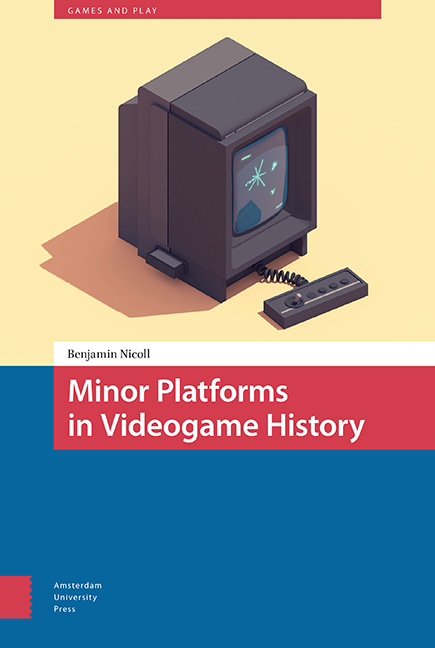Book contents
- Frontmatter
- Contents
- List of Tables and Figures
- Acknowledgements
- Introduction : Failed, Forgotten, or Overlooked? Methods for Historicizing Minor Platforms
- 1 Ways of Seeing Videogame History: The Vectrex as a Transitional Platform
- 2 Articulations of Videogame Piracy: The Zemmix as a Decolonial Platform
- 3 Domesticating the Arcade: The Neo Geo as an Imaginary Platform
- 4 A Dialectic of Obsolescence? The Sega Saturn as a Residual Platform
- 5 ‘How History Arrives’: Twine as a Minor Platform
- Conclusion: ‘Something new in the Old’
- Index
1 - Ways of Seeing Videogame History: The Vectrex as a Transitional Platform
Published online by Cambridge University Press: 21 November 2020
- Frontmatter
- Contents
- List of Tables and Figures
- Acknowledgements
- Introduction : Failed, Forgotten, or Overlooked? Methods for Historicizing Minor Platforms
- 1 Ways of Seeing Videogame History: The Vectrex as a Transitional Platform
- 2 Articulations of Videogame Piracy: The Zemmix as a Decolonial Platform
- 3 Domesticating the Arcade: The Neo Geo as an Imaginary Platform
- 4 A Dialectic of Obsolescence? The Sega Saturn as a Residual Platform
- 5 ‘How History Arrives’: Twine as a Minor Platform
- Conclusion: ‘Something new in the Old’
- Index
Summary
Abstract
This chapter analyses the Vectrex, a vector-based home videogame platform released in North America in 1982. The Vectrex utilizes an inbuilt ‘random-scan’ cathode ray tube monitor to display images in vector graphics. While it is tempting to view the Vectrex as a historical oddity or ‘dead end’ in the history of videogames, I argue that it can more productively be understood as a signifier of transition—of the convergence of various aesthetic trajectories, technical systems, and interfacing techniques during a moment of uncertainty and instability in videogame history. To make this argument, I analyse the platform's technical construction against the backdrop of broader histories of visualization in art and computer graphics.
Keywords: Vectrex, vector graphics, interface, platform studies, visual culture, ways of seeing
Videogames inherit many of their aesthetic qualities from a deep lineage of representational media and visual techniques. Alexander Galloway (2006: 40) notes that early first-person shooter videogames, for example, built on a direct legacy of photographic and cinematic techniques for structuring embodied vision. In a similar vein, Angela Ndalianis (2004: 102) suggests that videogames such as Doom (id Software, 1993) possess a labyrinthine logic similar to that which proliferated in baroque art and culture in sixteenthcentury Europe. David Surman (2009: 165) argues that Pokémon's visual style draws influence from a long history of Japanese art and design, namely the ‘recurring form of the silhouette’. However, it is important to recognize that in the early years of videogame development, these aesthetic conventions were never inherited wholesale, as if passed down a family tree and faithfully reproduced on computer and television displays. Rather, programmers often had to shoehorn established visual techniques (such as perspectival projection) into their videogames through extensive experimentation and manipulation. For example, the developers of the arcade videogame Q*bert (Gottlieb, 1982) utilized an isometric technique that straddled multiple visual systems—both artistic and technical—in order to simulate the illusion of perspectival space on an arcade monitor with limited technical affordances (see Gaboury, 2016: 361-362).
- Type
- Chapter
- Information
- Minor Platforms in Videogame History , pp. 45 - 72Publisher: Amsterdam University PressPrint publication year: 2019



